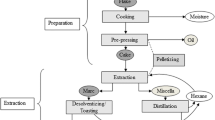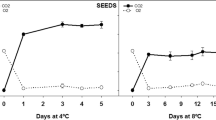Abstract
Amaranth was a major crop among the Aztecs. In Mexico the seed is popped and eaten with brown sugar. The crude protein content of the seed is 14±2% but its contents of lysine and tryptophan are 6.2 and 1.6 g/16 g N respectively. We developed a popping method based on a fluid bed system (FBS) whereas the traditional method (TM) is just to pop the seeds manually in a hot plate. Assays carried out were evaluation of racemization of the amaranth protein due to heat treatment, amino acid composition of the raw and heat treated seeds and a biological experiment testing whether leucine was the most limiting amino acid of amaranth protein. Male rats were fed both popped amaranths and roasted amaranth. Parboiled amaranth and casein were controls. The results were: (a) Lys, Arg and Cys were damaged in the heat treated seeds; (b) Asp, Met, Glu, Ala and Phe were racemized in that decreasing order in the seeds popped and roasted by the TM; (c) the estimated net protein retention (NPR) and estimated net protein utilization (NPU) of popped amaranths by either method were not different, but were lower than for the parboiled amaranth. The parboiled amaranth was not different from casein; (d) Leu was not the most limiting amino acid in any of the amaranth seeds tested. After Lys, sulfur amino acids appear to be the next most limiting in severely heat treated amaranth. The FBS seems to be a promising method for popping amaranth at industrial level.
Similar content being viewed by others
References
Alvarez M (1987) Digestibilidad aparente del triptofano proveniente de la semilla procesada de A. hypochondriacus B Sc Thesis Mexico City: University of Mexico, Faculty of Chemistry
Association of Official Analytical Chemists (1980) Official Methods of Analysis, 13th edn. Washington D.C.: AOAC
Betschart AA, Irving DW, Shepherd AD, Saunders RM (1981) Amaranthus cruentus: milling characteristics, distribution of nutrients within seeds components, and the effects of temperature on nutritional quality. J Food Sci 46: 1181–1187
Bjarson J, Carpenter KJ (1970) Mechanisms of heat damaged in proteins. 2. Chemical changes in pure proteins. Br J Nutr 24: 313–329
Bressani R (1983) Calidad protéinica de la semilla de amaranto cruda y procesada. En: Arch Latinoam Nutr (ed) El amaranto y su potencial. Bol 3. Guatemala: INCAP
Downton WJS (1973) Amaranthus edulis. World Crops 25: 20
Duncan DB (1955) Multiple range and multiple F tests. Biometrics 11: 1–42
García LA, Alfaro MA, Bressani R (1987) Digestibility and protein quality of raw and heat-processed defatted and non-defatted flours prepared with three amaranth species. J Agric Food Chem 35: 604–607
Hurrell RF, Carpenter KJ (1977) Nutritional significance of cross-link formation during food processing. In: Friedman M (ed.) Advances in experimental medicine in biology. Symposium on protein cross-linking. Nutritional and medical consequences. Vol 86B Plenum Press, pp. 225–238
Kauffman CS, Bailey NN, Volak BT, Weber LE, Volk NR (1984) Amaranth grain production guide. Kutztown, Penn: Rodale Research Center. New Crops Dept
Marx JL (1977) Amaranth: a comeback for the food of the Aztecs? Science 198: 40
McLaughlan JM (1976) The relative nitrogen utilization method for evaluating protein quality. J Assoc Offic Anal Chem 59: 42–45
Miller DS, Bender AE (1955) The determination of the net utilization of proteins by a shortened method. Br J Nutr 9: 382–388
Miller EL (1967) Determination of the tryptophan content of feeding stuffs with particular reference to cereals. J Sci Fd Agric 18: 381–386
Moore S, Spackman DH, Stein WH (1958) Chromatography of amino acids on sulfonated polystyrene resins. An improved system. Anal Chem 30: 1185–1190
National Research Council (1978) Nutrient requirements of laboratory animal. 3rd revised edn. Washington D.C.: National Academy of Science
Ortiz de Montellano BR (1978) Aztec cannibalism: an ecological necessity? Science 200: 611–617
Pant KC (1986) The effect of amino acid or protein supplementation on the nutritional quality of grain amaranth. J Food Sci Tech. India 23: 298–300
Pedersen B, Kalinowski LS, Eggum BO (1987) The nutritive value of amaranth grain (Amaranthus caudatus) 1. Protein and minerals of raw and processed grain. Plant Foods Hum Nutr 36: 309–324
Po Lin C, Po Chao H (1986) Comparison of control diets containing various proteins levels for determining net protein utilization by rats. J Nutr 116: 216–222
Sánchez Marroquín A (1983) Two forgotten crops of agroindustrial importance: amaranth and quinua. Arch Latinoam Nutr 33: 11–32
Saunders RM, Becker R (1984) Amaranthus: a potential food and feed resource. In: Pomeranz Y (ed.) Advances in Cereal Science and Technology. Vol. VI. Minnesota: AACC, pp. 357–396
Schwass DE, Finley JW (1984) Heat and alkaline damage to proteins: racemization and lysinoalanine formation. J Agric Food Chem 32: 1377–1382
Teutonico RA, Knorr D (1984) Amaranth: composition, properties and applications of a rediscovered food crop. Food Tech 39: 49–59
Tovar LR, Carpenter KJ (1982) The effects on alkali-cooking of corn and supplementation with amaranth seed on its deficiencies in lysine and tryptophan. Arch Latinoam Nutr 32: 961–972
Tovar LR, Schwass DE (1983) D-amino acids in processed proteins: their nutritional consequences. In: Finley JW, Schwass DE (eds) Xenobiotics in foods and feeds. Washington D.C.: ACS Symposium Series No. 234, pp. 169–185
Tovar LR, Barrios T, Valdivia MA (1984) Fuentes de suplementación o sustitución en tortillas de maíz: Amaranthus hypochondriacus y Sorghum vulgare. En: Memorias del 1 er Seminario Nacional de Amaranto Vol. I. Chapingo Mexico, pp. 193–199
Varnish SA, Carpenter KJ (1975) Mechanisms of heat damage in proteins. 6. The digestibility of individual amino acids in heated and propionylated proteins. Br J Nutr 34: 339–349
Zezulka AY, Calloway DH (1976) Nitrogen retention in men fed isolated soybean protein supplemented with L-methionine, D-methionine N-acetyl-L-methionine, or inorganic sulfate. J Nutr 106: 1286–1291
Author information
Authors and Affiliations
Rights and permissions
About this article
Cite this article
Tovar, L.R., Brito, E., Takahashi, T. et al. Dry heat popping of amaranth seed might damage some of its essential amino acids. Plant Food Hum Nutr 39, 299–309 (1989). https://doi.org/10.1007/BF01092066
Issue Date:
DOI: https://doi.org/10.1007/BF01092066




